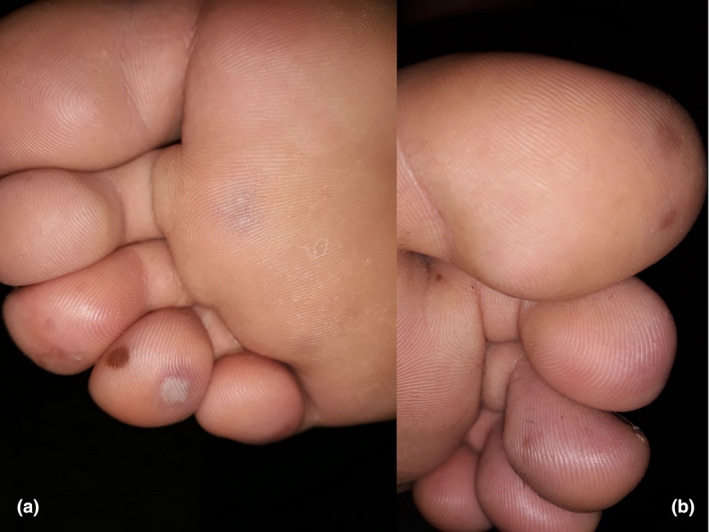Dear Editor,
The coronavirus disease 2019 (COVID‐19) pandemic has spread worldwide in a few months. 1 , 2 In the emerging literature, skin seemed to be involved in only 0.2% of patients, and notations of cutaneous findings have been generically described as “rash”. 3
During the rapid spread of SARS‐CoV‐2 infection in Italy, pediatric dermatologists received pictures from pediatricians reporting young patients with pernio‐like lesions. 4 The clinical features appeared to be stereotypical, with the sudden onset of slightly painful or pruritic violaceous plaques and nodules, sometimes bullous, on the fingers and toes (Figs. 1 and 2). Most of the children and their parents were well or had a recent history of mild fever and/or respiratory or gastrointestinal symptoms. Direct or indirect contact with a case of COVID‐19 was reported in only a few cases. Because of the quarantine in Italy, initially testing all patients with chilblain‐like lesion for SARS‐CoV‐2 infection was not possible, but with the lifting of the lockdown, we started to perform screening. The results were interesting, in fact among tested children, all were negative to serology and swabs, except for one child who still had parents with direct positivity for COVID‐19 infection. The negativity of this screening may be justified by the rapid decrease of the viral load on blood polymerase chain reaction (PCR) after the symptoms started. Screening for other viruses also showed inconsistent results, therefore the potential viral cause of pernio‐like lesions was not confirmed. Nevertheless, several clues suggested a possible relationship with SARS‐CoV‐2: the appearance of an outbreak of chilblain‐like lesions in close association with the escalating COVID‐19 epidemic; the “out‐of‐ season” timing for chilblains, which usually are caused by exposure to cold, whereas our patients were under quarantine at home; 5 an apparent latency period of several days between minor general symptoms and onset of skin lesions, which is compatible with an immune‐mediated pathophysiology; apparent age‐related sparing of children and adolescents for severe COVID‐19 yet an opposite age‐predilection for the cutaneous manifestations, which may indicate a particular immunologic response favoring cutaneous lesions; and the similarity of the possible “ischemic” cutaneous reaction and pulmonary damage reported in patients with COVID‐19. Microangiopathy involving the skin could be because of thromboses, as are seen due to the hypercoagulable state found in adults with COVID and manifesting as major thrombotic events, or vasculitis. A final, but seemingly less likely, possibility is that physical inactivity during quarantine could lead to vascular stasis and microthrombosis.
Figure 1.

(a) Painful nodule of the second toe in a 14‐year‐old girl; (b) multiple violaceous nodules of the toes; (c) hemorrhagic blister of the third toe; (d) chilblain‐like lesions of the hands
Figure 2.

Itchy and painful nodules with blistering of the soles in a 13‐year‐old boy (a,b)
We actually think that after the first negative results of the screening program, the correlation of these lesions with the COVID‐19 infection is far from being confirmed, so clinicians have not to worry parents, avoiding to forward urgently children to the nearest hospital to perform all the COVID examinations. Evidently wider screening of symptomatic children will be necessary to definitively clarify this condition.
Conflict of interest: None.
Funding source: None.
References
- 1. Piccolo V, Argenziano G. The impact on novel coranovirus on Dermatology. Dermatol Pract Concept. 2020;10(2):e2020049 [DOI] [PMC free article] [PubMed] [Google Scholar]
- 2. Coronavirus COVID‐19 Global Cases by the Center for Systems Science and Engineering (CSEE) at JohnHopkins University (JHU). Available at: https://coronavirus.jhu.edu/map.html. Accessed April 6th, 2020.
- 3. Guan WJ, Ni ZY, Hu Y, et al. Clinical characteristics of coronavirus disease 2019 in China [published online ahead of print, 2020 Feb 28]. N Engl J Med 2020;382(18):1708–1720. 10.1056/NEJMoa2002032 [DOI] [PMC free article] [PubMed] [Google Scholar]
- 4. Recalcati S. Cutaneous manifestations in COVID‐19: a first perspective. J Eur Acad Dermatol Venereol 2020;34(5):e212–e213. 10.1111/jdv.16387 [DOI] [PubMed] [Google Scholar]
- 5. Piccolo V, Neri I, Filippeschi C, et al. Chilblain‐like lesions during COVID‐19 epidemic: a preliminary study on 63 patients. J Eur Acad Dermatol Venereol 2020. 10.1111/jdv.16526 [DOI] [PMC free article] [PubMed] [Google Scholar]


